Pause, please.
40 years of published and awarded research on skin, hypoallergenicity, and clinically-effective care has led us more and more to this fact: what affects the skin is far more than what is applied on it.
Science is showing just how interdependent — how linked — all aspects of our health are. The care of skin cannot be separated from what we eat, how often we exercise, underlying health conditions, and how well we sleep and manage stress.
It’s time to pause, review, and share some of the most proven ways to care for all aspects of health — skin, body, and mind.

1. Listen To Your Skin
Your skin shows you what’s really going on. Pay attention.a) Our topmost tip from 40 years of clinical research and making allergen-free products: the 7-Day Skin Fast. This one technique has been the most successful at getting angry skin to calm down and prepped to re-start any skincare. Over the course of multiple decades, we have received less than 0.1% reports of reactions. Of the few reactions reported, almost all were due to incorrect use of the product, a cross reaction with another brand’s product, or an underlying irritation that might have been chronic but not yet obvious. In these cases, a 7-Day Skin Fast resulted in a clearing of the problem and being able to re-use most products without issue. Similar to an elimination diet for food, but for skin, the Skin “Detox” Kit contains everything you need to do a 7-Day Skin Fast, and full instructions can be found here.b) One of the biggest problems of using several products (especially across different brands) is making it more complicated to identify what might be the cause of a reaction (it is not always — or even frequently — the last product you applied). Keep your regimen simple, and follow strict allergen avoidance based on your patch test results.c) Your skin is speaking to you: trust its patterns. The patterns of your acne, rashes, dry patches, and dark splotches can be the roadmap to their solution. See a dermatologist who is an expert in contact acne or contact dermatitis to help you interpret what your skin problems’ patterns might be telling you.d) Seasonal adjustments to your skincare routine will help your skin adapt to new climates. A richer cleanser, moisturizer and hydrating mask may be an option in the Fall and Winter. Use an exfoliating toner and more lightweight products in warmer weather and climates.

2. Touch Is Healing
Soothing touch can cause the release of serotonin, the chemical in our brains that boosts positive moods and helps us feel more connected to our bodies. Facial and body massages relax muscles, get the blood flowing in the skin, and decrease cortisol levels.

3. Be Kind To Your Eyes
Preparing for a big event? Avoid salty foods for a few days prior and sleep with your head elevated on two pillows the night before. Both steps prevent fluid retention around the eyes. A gentle eye serum with a temporary tightening effect gives you extra oomph on the day itself.Another great tip for puffy eyes: try a cold compress with virgin coconut oil or Boo-Boo Balm. The cold and anti-inflammatories can help bring down swelling.Yellow concealer (like our Skin-The-Bluff in “No More Blues”) does wonders for camouflaging dark circles under the eyes.
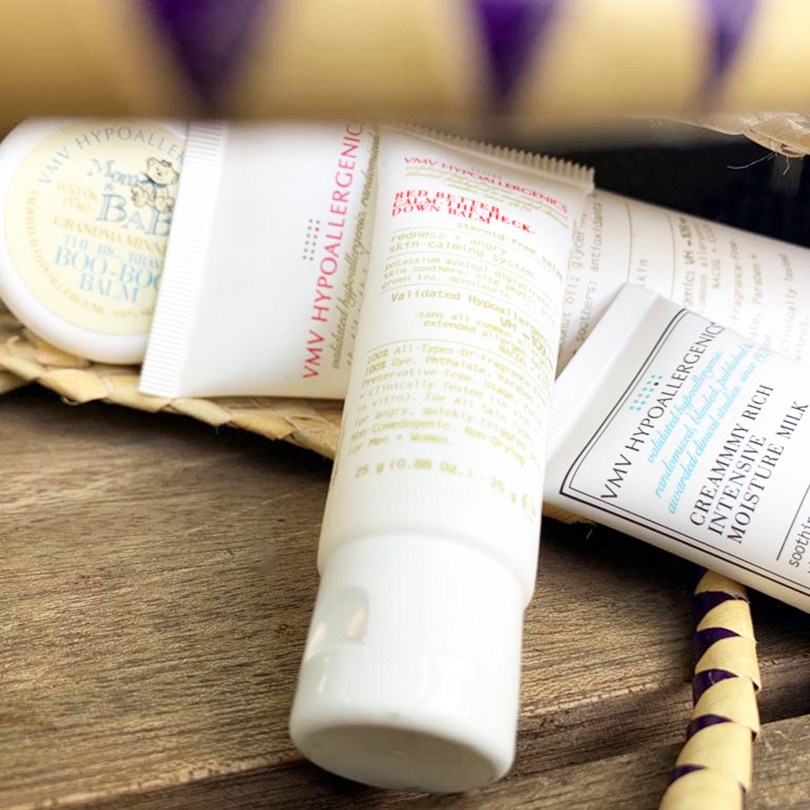
4. For Sensitive Skin Conditions: Think Patch-Tested, Simple & Steroid-Free.
Psoriasis, atopic dermatitis (eczema), rosacea, and other inflammatory skin conditions can be relatively straightforward to manage with strict allergen avoidance and a simple, anti-inflammatory, barrier-rebuilding skin regimen. Topical steroids may be necessary for emergencies but keep in mind that they are not meant for long-term use. In addition to thinning the skin and potentially causing serious health problems, prolonged steroid use can cause a “rebound effect” when trying to get off of them.What have we learned is the best way to manage highly sensitive, reactive, or inflammatory skin conditions?1) See a dermatologist who is an expert in your skin condition, such as a doctor who is a member of the American Contact Dermatitis Society. They will probably prescribe a patch test to more accurately identify what your allergens are.2) Armed with your list of allergens, now you can avoid them in your skincare, makeup, shampoos…even clothing and digital equipment!3) Keep your skincare regimen ultra-simple and allergen-free. Include…• An ultra-gentle cream cleanser;• A few moisturizers (for daily use, plus for periods of heightened dryness) that have antimicrobial properties to combat the opportunistic microbes that can invade skin and cause additional dryness and itching;• A soothing, quick-healing balm for redness, rashes, or itching…plus a steroid-free anti-inflammatory that hopefully can prevent the need for a steroid when a flare-up begins. IMPORTANT: if your doctor says a steroid is needed, it is needed. You might also need additional medication for an emergency. Follow your doctor’s instructions. The allergen avoidance and steroid-free alternatives are to help you avoid emergencies but should one occur, you must follow your doctors’ instructions.• A purely physical sunscreen that doubles as thick barrier protection to add a layer against contaminants.• Ultra-gentle shampoo, conditioner and other allergen-free body and bath care and even laundry soap to keep triggers at bay.Need help choosing products based on your patch test results? Ask us via a Private Message on Facebook or through a request on our website! We can customize recommendations based on your particular results (we take into account possible cross reactants, too!).

5. Skin Prep
Before an important makeup application, you should always prep your skin to achieve a flawless canvas for makeup. If the skin isn’t fully prepped, the makeup will not deliver the desired look. If there’s no time for a quick mask, carefully massage the face with your choice of a moisturizer using gentle circular motions to add vitality. This simple step reduces puffiness, relaxes the tissue, and lifts the skin.
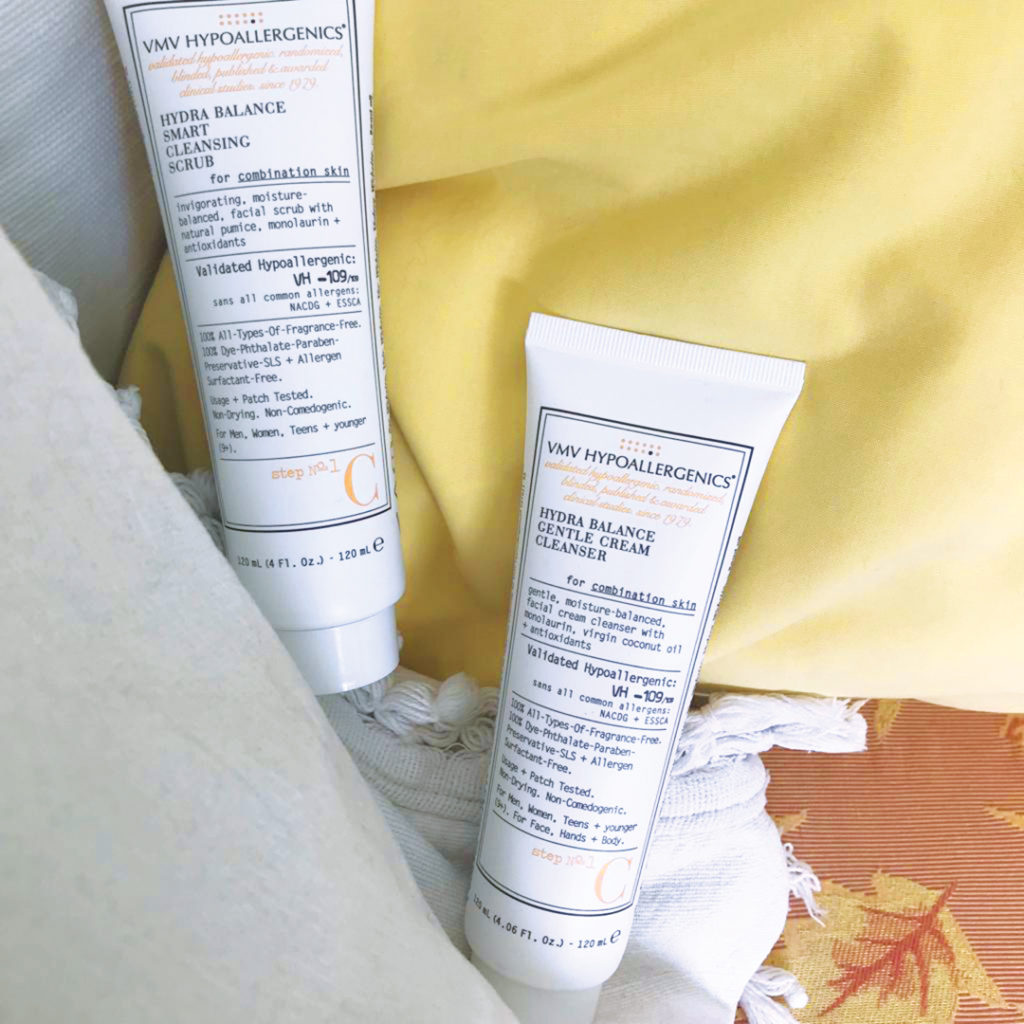
6. Practice GENTLE Exfoliation…And Never Use a Bar Soap For The Face!
Because of the way they are made, bar soaps inherently have very high pH levels (they are quite basic). On the other hand, the skin’s natural pH is slightly acidic. If you use active ingredients, the pH can drop even more, which is why you need a pH-adjusted cleanser like Re-Everything, Illuminants, or Id when using active treatments. Cream cleansers are your best bet to prevent denaturing (drying out or irritating the skin), which commonly happens with high-pH bar soaps.Daily exfoliation with overly harsh scrubs or brushes can be aggressive and contribute to breakouts — scrubbing brushes in particular can spread bacteria and encourage acne. Use a skin type-appropriate exfoliator instead. When washing your face, do not press down or rub vigorously, or scrub any section of your skin for longer than a second or two — a light, gentle massage is really all you need.If your skin is very sensitive, use a mild, hypoallergenic scrub 1-2 times a week and alternate with a soothing non-foaming face wash as a surefire skin regimen.

7. Eat Greens For Glowing Skin
Because skin health begins “skinside,” ups your intake of green veggies like kale, spinach and arugula to help increase your skin’s visible radiance and achieve a blemish-free complexion. Add greens or a side salad to your lunch and dinner.Scratch that…increase your fresh, organic fruit and vegetable intake whenever you can! A recent study shows that an anti-inflammatory diet can help decrease inflammation in the skin, too.The less processed the better, so choose fresh over cooked. Adding healthy root crops like sweet potato can up the “yum factor” while giving you a fabulous boost of fiber and antioxidants, too!

8. Mattify
If your skin tends to get shiny throughout the day, apply a matte finish toner or gel as a final skincare step. If you use makeup, apply the mattifier as a last step prior to makeup application. It will prevent the need for excessive powder touch ups later on.

9. Skincare and Hair Care Can Be Mutually Beneficial!
There are several ways that skincare helps your hair and vice versa:1) First, remember this: your shampoo and conditioner can help your skin or hurt your skin. Comedogens and allergens in the formulation can trickle down onto skin to cause acne or irritations. Allergen- and comedogen-free options can help keep skin clear.2) Sunscreen can protect your hair and scalp. Mix coconut oil and a dime size amount of SPF in the palms of your hands. Apply it from mid-shaft to ends. The SPF will protect your hair from sun and chlorine, while the coconut oil adds extra hydration, strength and shine.3) Your skincare can double as an intensive hydration treatment. In between salon appointments, try this: shampoo and condition your hair. While it’s wet, comb Know-It-Oil virgin coconut oil through it. Then, take cling wrap and wrap it around your hair. Leave on for about 30-60 minutes, then rinse. It may take several rinses to get past the wet-beachy look but the oil’s prolonged penetration (aided by the heat trapped by the wrap) does so much good for the hair and scalp.4) Combine skincare and haircare for a DIY leave-in conditioning pomade. Place a pea-sized amount of Boo-Boo Balm on the palm of your hand. Add one pump of Essence Skin-Saving Conditioner next to the Boo Boo Balm. Rub your palms together until the mixture turns clear. Using the palms of your hands, massage the product onto your hair, working outwards from roots to ends. Style as usual. Your hair will glisten and shine, and feel soft and hydrated throughout the day.
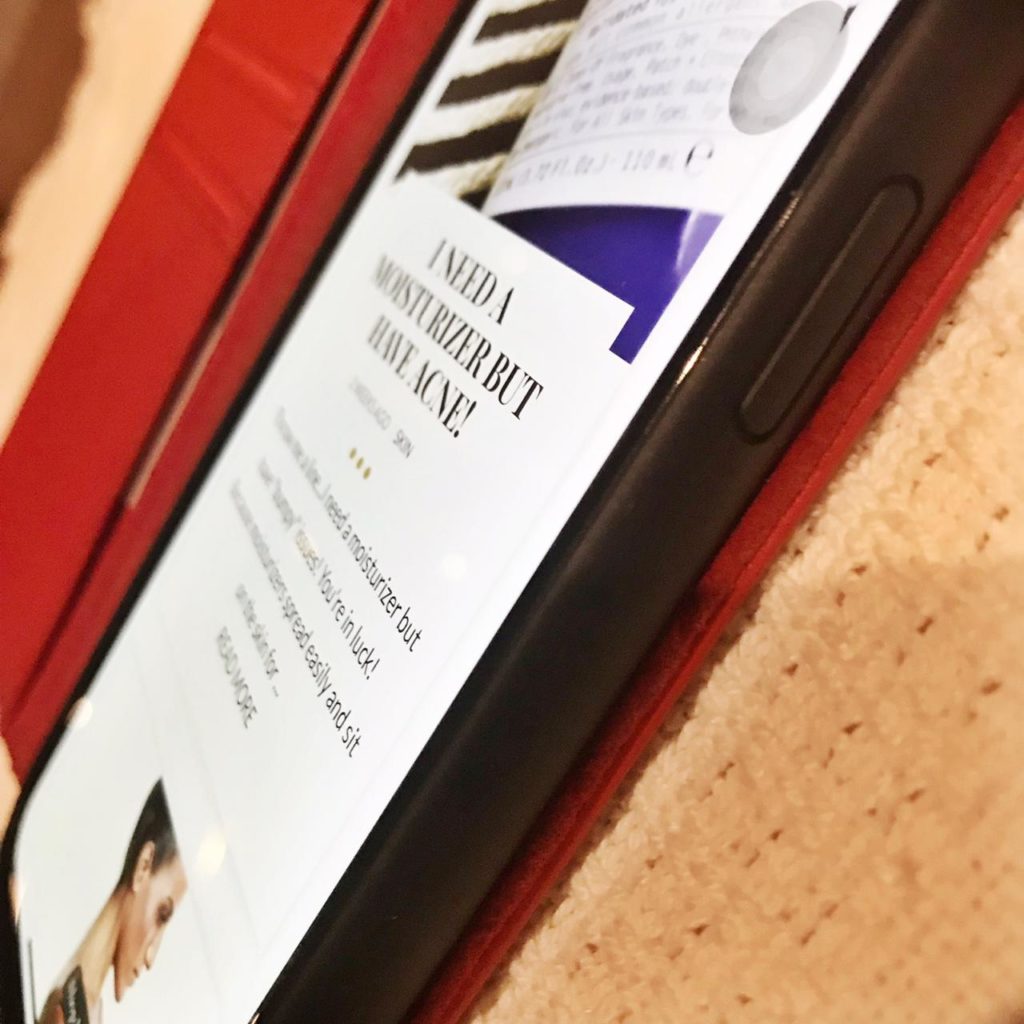
10. Clean Phone, Clean Skin
Our phones are covered in oils and bacteria. Putting your phone to your face can lead to breakouts along the cheek and jaw line. Clean your phone with a paper towel and antibacterial hand gel to help keep your skin clear.Also, if you’ve patch tested positive for things like nickel, dyes, or rubber-related substances, be extra careful when touching your phone and choosing a phone cover. Many of these items contain these allergens.
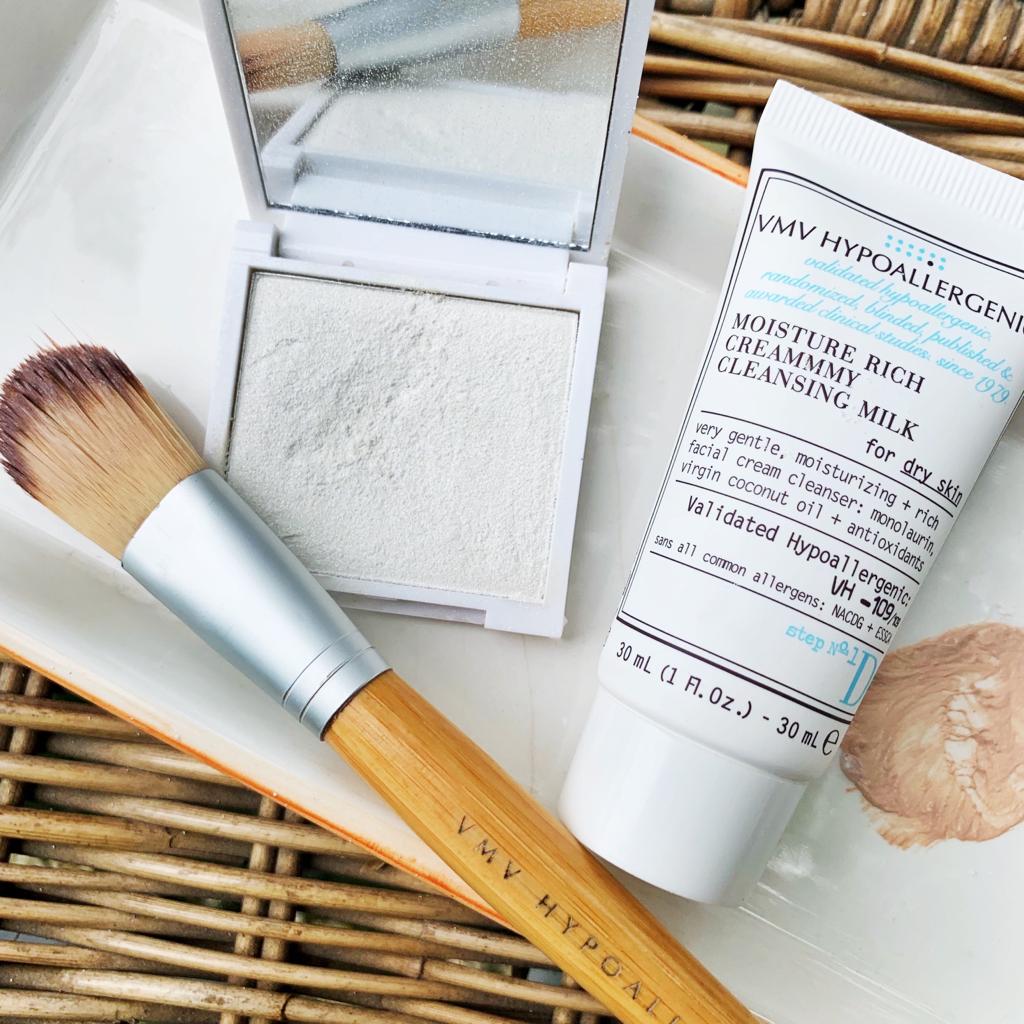
11. Customize Your Foundation Finish!
You might have a dependable foundation but want to try different effects. Don’t splurge on multiple products just yet because you can use your fave foundation — tweaked just slightly — to achieve other finishes!1) To achieve the illusion of a flawless base in one application, use the back of your hand as a palette and create a custom blend.2) For less coverage, mix equal parts moisturizer and liquid foundation.3) For a dewy look, mix 1-2 drops of your desired oil into the liquid foundation.4) For highlights that look more “built into” your skin (as opposed to “sitting on top” of it), sift gold or white shadows into your liquid foundation.5) For a naturally sun-kissed look with subtle shimmer that’s incredibly flattering, scrape a smidge of Tarte-à-Tan coconut oil bronzing powder with foundation before application

12. Lift Your Smile
Tap and blend concealer on the outer corners of your lips for a natural, visual lift before applying lip color.

13. Multi-Purpose Cream Makeup Makes It Easy To Tap & Glow!
Using a cream color, tap onto eyelids and blend just beyond the crease. Tap the same product onto the lips and cheeks to spread that radiance over the face. The result is a softer, more youthful look that is less constructed and more natural…all with one product!

14. Brow Know-How
Subtle alterations of the brows can transform your makeup look and mood. Filled-in brows will add symmetry to the face and define the eye contours. Create hair-like strokes with a flat definer brush while using brow-shadowing shades that compliment your hair color. Keep brow hairs in place with light strokes of mascara, or lightly brush through them with coconut oil.

15. Color-Correcting Concealers…
…are practically magic once you understand a little bit of color theory:Opposite colors cancel each other out:• Green pigments cancel out redness from breakouts and on concentrated areas such as around the creases of the nose.
• Yellow pigments cancel out blue or purple areas around the eyes such as dark circles or deep-set corners, as well as dark patches of hyperpigmented skin.The popular “Hollywood V” technique lessens the appearance of under eye circles. With a concealer brush, swipe the color-correcting concealer under your eye in a “V” shape from the outer to inner corner. Working upwards, buff and feather the concealer towards the center of your lower lid, then feather out edges.

16. Cheat Sheet to Eyeshadows
Pick opposite hues for the most flattering eyeshadows that make your eye color naturally pop.For blue eyes: warm undertones of orange, gold, apricot, or peach.For green eyes: reddish undertones, like deep plums and wine, work wonders.Brown eyes…are neutral and can carry any color. Try blue, purple, or green to enhance color intensity.

17. Spa Days Are Health Days
Your emotional and mental wellbeing can be positively impacted by treatments such as facials, massages, and body healing. Spa visits promote stress relief and relaxation, and will absolutely aid in your reaching your beauty, stress management, and wellness goals!

18. Mindfully Manage Stress
High levels of tension and stress can lead to breakouts or aggravate skin conditions such as psoriasis, rosacea, and eczema. Be mindful of stress triggers and make a conscious effort to take time out. Your skin will thank you. Simple yoga like child’s pose, downward dog and sun salutations can increase blood circulation and boost oxygen. Regular practice can reduce inflammation and stress.

19. Test First, Use Second
When using a new product, always test it on a small area of skin first (what we call a Provisional Patch Test). Wait at least 24 hours for signs of irritation, redness, or inflammation. If you have a history of irritations, repeat this again several days in a row before using the product regularly. If your skin is hypersensitive, do a 7-Day Skin Fast using our Skin Detox Kit, or ask your dermatologist about a patch test and then ask us to customize recommendations for you based on your results!

20. Powders & Foundations = Added Protection From Layering!
This is a “best-kept-secret” tip that comes as a surprise to many people, including some industry professionals and doctors: powders and foundations up your sun and light protection. This is especially true if they contain sunscreen ingredients, but even if they do not, adding foundation or powder can help increase your protection via a concept called “layering.” Much like wearing a hat or long-sleeved shirt, foundation and powder serve as extra barriers against harmful rays.Pat on with a puff or sponge for even coverage and higher protection than using a brush. Our powder-foundations can even be used both ways! Applied with a moistened sponge, they’re foundations that provide more coverage. Brushed or patted on dry, they’re lighter powders for less opaque applications and touch-ups throughout the day.

21. Travel Cat Nap
Apply eye cream, close your eyes, and wear a sleeping eye mask during air travel. Snooze or meditate to arrive feeling fresher and more relaxed at your destination. And remember: cat naps aren’t just for travel! Slot in 15 minutes for a quick shut-eye in the middle of the day.

22. Overnight Renewal
Keep two must-haves on your nightstand for overnight renewal of hands and lips.

23. Read Product Labels, and Choose Less For More.
Especially for sensitive skin, these are some best practices:1) Look for products free of fragrances and preservatives which are two common causes of irritations and flare-ups.2) If you’ve had a patch test, carefully examine ingredients lists for your allergens (and other names that they go by). If you are concerned about missing one of your allergens because it has other names, ask us to help customize recommendations for you based specifically on your patch test results.3) If you have not yet had a patch test but have a history of reactions to products applied on your skin, look for the highest VH Rating on one of our products. The higher the number, the more published common allergens are ABSENT in a formulation.4) The shorter the ingredient list, the less complicated the formula and the less possible cross reactions. The American Academy of Dermatology recommends using products with less than 10 ingredients for sensitive skin. Of course, products that contain zero of all known common allergens (as published by reliable sources like the American Contact Dermatitis Society) are the safest. Following product usage directions is also very important, especially for products with active ingredients.

24. Fatty Acids Are Your Skin’s Best Friends!
The fatty acids in virgin coconut oil (VCO) mimic your skin’s natural oils and keep skin moisturized longer without feeling greasy. VCO also helps repair the skin’s damaged barrier layer, which can happen with some conditions like eczema. VCO also has natural anti-microbial properties. This is important to fight opportunistic microbes that can enter cracks in very dry skin, which can lead to itching and increasing dryness.When eaten — alone, in your “bullet coffee,” poured onto salads, or even when cooking — VCO gives you lots of healthy benefits that are great for your heart and cells.Can all VCOs be used for skin? Yes and no. Not all VCOs are created equal. While there are no reports of contact allergies to organic, pure, virgin coconut oil, there have been to RBD (refined, bleached, deodorized) oils.What about in food? Coconut oil is so good for you that even RBD coconut oil (which is odorless and flavorless, and works better with some dishes) is a better choice than rapeseed, sunflower, corn, and other vegetable oils.

25. Relax
The easiest way to relax is to smile. Turn the corners of your mouth up and let your eyes shine through.Feeling anxious? Try the 5-4-3-2-1 grounding technique:
? Name 5 things you can see…
?? 4 things you can touch or feel…
?? 3 things you can hear…
?? 2 things you can smell…
? 1 thing you can taste.? Top it off with 4 cycles of square breathing:
Inhale for 4 counts ••• hold for 4 counts ••• exhale for 4 counts ••• hold for 4 counts. Repeat 4 times.IMAGE: VMV Brand Ambassador Elaine Abonal ? Oli Bayer

26. Classic Makeup & Wardrobe Pairing
French fries and ketchup, peanut butter and jelly. Here are a few can’t-go-wrong wardrobe and makeup pairings:
• Bronze and navy are complimentary colors. Switch it up with bronze clothing and navy shadows, or vice-versa.
• In block colors? Keep the face neutral but add a pop of a bright, bold eyeliner.
• Wearing stripes or polka dots? A bold red or fuchsia or lip is the perfect counterpoint.
• Metallics and white: makeup with a sheen works well with white clothing. Keep the skin dewy and warm with a fresh touch of bronzer.
• Red lips and a red outfit work with different tones of red.
• Neutral makeup flatters jewel-toned clothes.
• Wearing all black, but bored with classic red lips? Try a deep red or burgundy instead.Check out Skintelligent Beauty makeup for a wide range of shades in performance makeup that won’t break you out in acne or a rash!
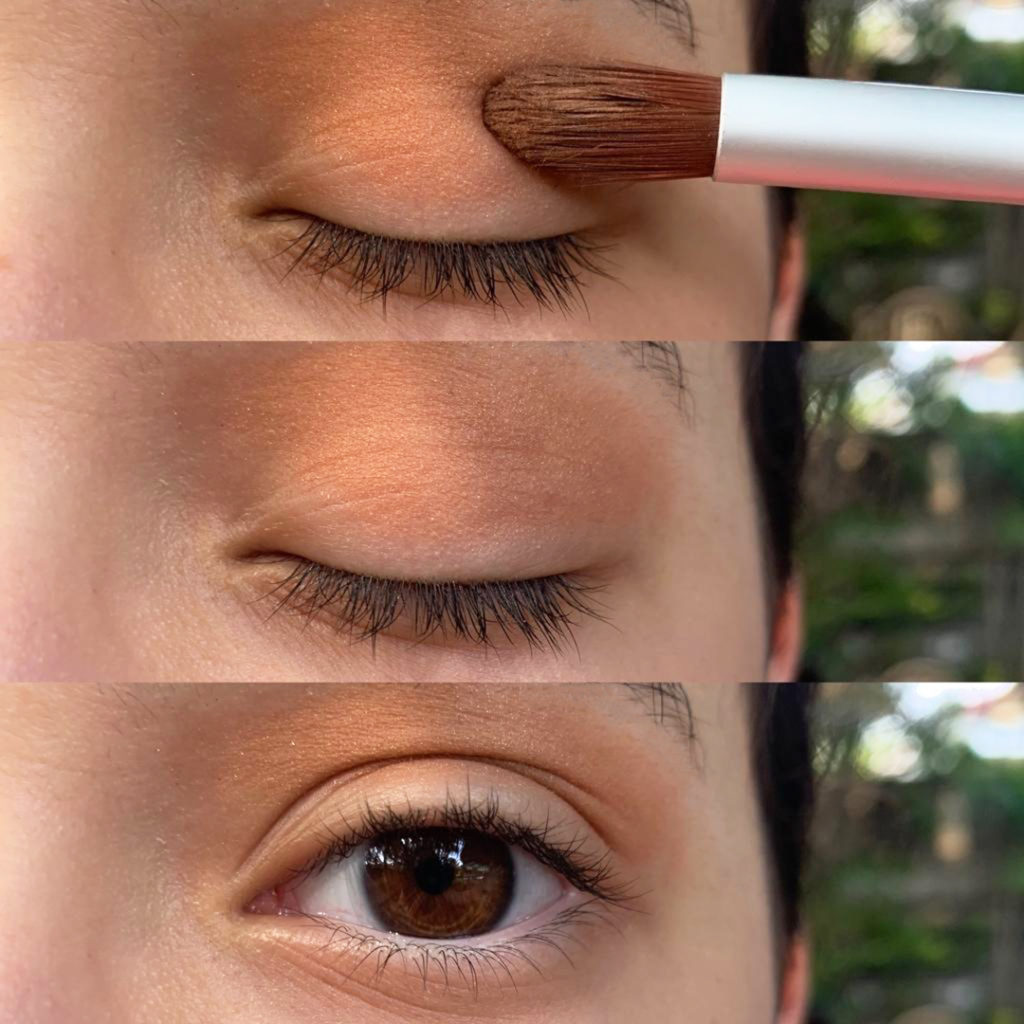
27. Sweep Eyes
No time for complex eye makeup? Using a large eyeshadow brush or blush brush, sweep a light bronzer across the eye crease to naturally define the eyes while enhancing the iris colour…in 5 literal seconds.

28. Blurred Lip
For beautiful color without the severity of a hard-edged matte (or the time needed for precision application) go for a blurred lip. Using your ring finger, pat on a your desired shade of lipstick, working from the center of the lip and blending outwards. This technique works well with deeper shades, reds and brighter colors you wish to subdue. For evening wear and low lighting, apply a small amount of concealer, powder or foundation around the vermilion border of the lips for a more defined look.
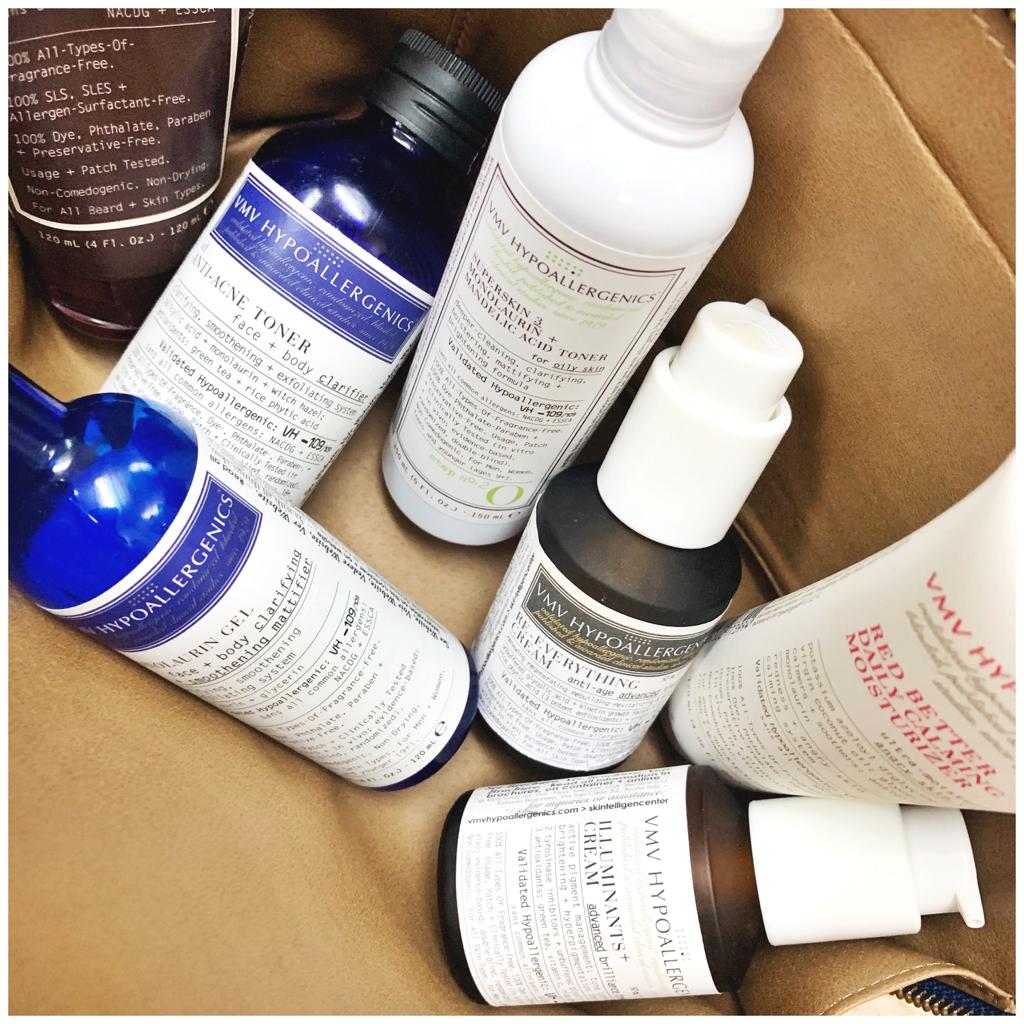
29. Get Active…With Your Skincare!
There is a lot of hype in the cosmetics industry…but also a lot of excellent, clinically-proven ingredients. Some all-stars include retinols, glycolic acid, mandelic acid, kojic acid, salicylic acid, potassium azeloyl diglycenate, virgin coconut oil, and monolaurin (which is in most of our products). Proven active ingredients provide real skin benefits like increasing cell turnover rate, treating acne, and helping to lighten hyperpigmentation. Just remember some key musts for skin safety:1) Make sure the rest of the formulation has zero allergens. Active ingredients are naturally slightly irritating. Reduce the risk of having to stop therapy by using a formulation that is otherwise as gentle as possible, and using other products in your regimen that are allergen- and irritant-free.2) Follow instructions carefully. Active ingredients should not be slathered on generously. Most shouldn’t be applied daily right away either — they require a slow build up in application frequency. Like, really slow. Start with twice-a-WEEK applications, for example. Then, slowly increase to 3x-a-week, then 1x-every-other day, until you achieve 1x or 2x-a-day applications (about 8 weeks after you started). This is the best way to prevent a reaction and get the most out of these powerful ingredients.3) Avoid the sun. Use a sunscreen daily, indoors and out, and whether or not a product with an active ingredient has been applied on a given day. Wear a hat and long-sleeved shirts, too. Many active ingredients increase your photosensitivity, so it’s important to increase your protection.

30. Sunscreen. Every. Day.
Regardless of the weather, wear a sunscreen. The American Academy of Dermatology recommends a daily minimum of SPF 30 and broad-spectrum UVA protection.Many SPF products also contain antioxidants to protect from free radicals and help neutralize UV damage…so that’s another reason to use them!When spending time outside, use a sunscreen with very high protection against UVA and UVB like Armada Sport 70. Reapply every 1-2 hours and after swimming or sweating.Choose creams over sprays or gels as most sunscreen actives mix best in creams. Also, it is still unclear how much product is absorbed or evaporates when using other mediums.If you’re photo-allergic, have very sensitive skin, are allergic to organic sunscreens, or are photosensitive due to active ingredients, dermatological procedures, chemotherapy, or other medicines or conditions, opt for a non-nanoparticle inorganic (mineral) sunscreen like Armada Post-Procedure 50+.If you’re NEVER outdoors, wear a sunscreen with protection factors against outdoor rays (UVA penetrates windows and windshields) but also indoor visible light — like Armada 30, 45, or 60. Indoor lights from reading lamps, computer screens, and even heat from cooking can cause melasma or other hyperpigmentations.

31. Keep Travel Skincare Simple…But Specific.
A travel skin routine should be simple — combat bacteria, adapt to dry or humid air, and take into account other possible changes such as water hardness and a different climate. All can contribute to face and body skin irritations. Cleanse, tone and moisturize, and include serums if you prefer. Don’t forget travel sizes of your basics like hair and body wash, conditioner, toothpaste, and antiperspirant…hotel amenities may trigger an unwelcome reaction.To avoid picking up unfamiliar bacteria that can result from car, bus, train, air, or other travel:• Avoid touching your face;
• Keep your hands clean; and
• Moisturize your face and hands.Airplanes can really dry out skin so choose a hand sanitizer that’s non-drying. Or, choose a moisturizer with a non-drying anti-microbial like coconut-derived monolaurin to carry just one product with multiple uses.The travel sizes of Mommycoddling All-Over Lotion, Essence Hand-Body Smoother, or any of our other moisturizers and lotions are great options.

32. Exercise Regularly (Ideally, Daily!)
Exercise increases blood flow and nourishes skin cells. Whether it’s a moderate 3X week or a ten minutes a day, exercise fuels the body and mind. It’s excellent for lessening stress and improving your mood, too!After exercise, wash your face with a scrub (for acne-prone skin) or cream cleanser (for very dry or sensitive skin) to get rid of sweat and excess oil without stripping skin of vital moisture.Don’t forget to pack your Essence Hair & Body Wash and Conditioner in your gym bag — they help prevent acne and gym amenities may not agree with your skin.Don’t forget your Id Monolaurin Gel to prevent sweat acne on the face as well as back, arms, chest, neck, thighs and butt! “Skinsider” tip: Id Monolaurin Gel doubles as a great hand sanitizer, which is so important at the gym.No time? Check out these 10-minute workouts!
• The 10-Minute Anywhere Workout,
• 10-Minute Heart Thumper Workout
• 10-Minute Pilates-Barre Workout.

33. Remove Makeup Before Cleansing To Prevent Over-Cleansing!
Always remove makeup prior to cleansing. Depending on your skin type and preference, you can use an oil-free remover or a makeup removing oil. Then, use your favorite cream cleanser or scrub after all makeup is off the skin. This makes sure you get all your makeup off without excessive cleansing or scrubbing.“Skinsider” Tip: decrease the chances of a skin reaction or acne by cleaning your makeup brushes after each use with a quick-drying antimicrobial cleanser like Instant, No-Rinse Hypoallergenic Brush Cleaner.
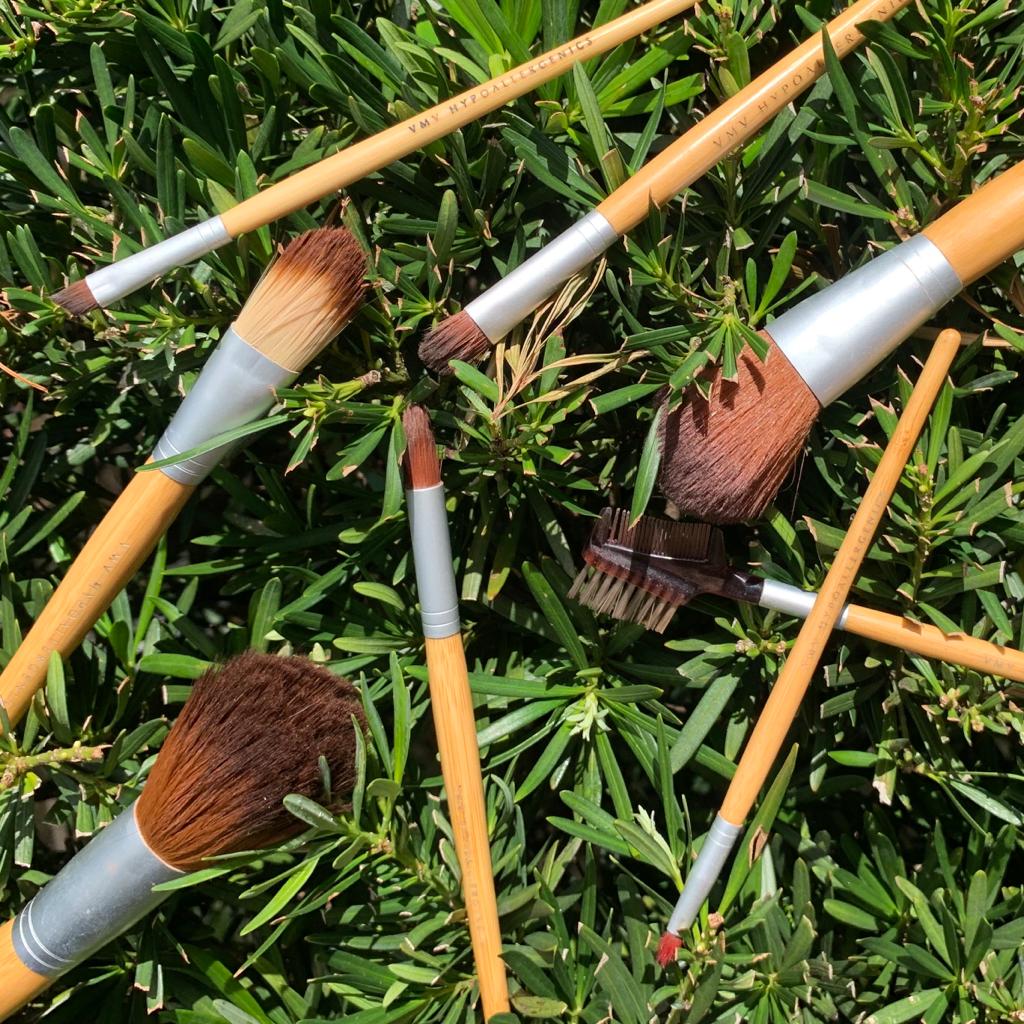
34. ALMOST ANYTHING Can Affect Your Skin.
There is a shocking amount of “stuff” that can affect your skin. Some of the top surprising ones include:1) Friction can irritate skin or worsen acne. In allergic or sensitive skin, excessive rubbing with rough materials can trigger redness or a flare-up. Gently pat your skin dry with a clean, white or natural (uncolored, unbleached) towel.2) Clothing: Related to the above, lots of clothes contain dyes, preservatives, and even chemicals like “mordants” which are related to metal and are used to help colorants bind better to synthetic fabrics. Choose natural and organic whenever you can. Indigo in jeans is a classic culprit, as are elastics in underwear. When in doubt, see your dermatologist who can study the patterns of your skin reactions to help determine if your clothing might be causing problems.3) Laundry detergent, brush washes, house cleaners: we touch a lot more than we might think. What can help the risk of a reaction is making sure that what we use to clean these multiple surfaces is also allergen-free, such as laundry soap and brush cleaner. If you can’t find ready-made hypoallergenic versions, try traditional cleaning hacks like vinegar.4) Airborne fragrances: scented candles and room sprays may be causing your contact dermatitis to flare.5) Makeup brushes, sponges, puffs, and other makeup applicators: we ask for raw material breakdowns and patch test all our applicators such as the puffs and sponges in our powder products and our makeup brushes. Many cosmetic applicators are made with allergens like dyes, rubber or rubber-related substances, glues, and more. Some also contain preservatives. In addition to allergens present in the material, we also consider texture as roughness can cause contact irritations.6) Spa and dermatological procedures: most items used in your spa or dermatologist’s visit are beneficial, but do watch out for allergens in essential oils or even hidden allergens in chemical peels or compounds used in some lasers.Your dermatologist will be able to guide you better regarding what things might contain your allergens. Check out our popular Allergen-Not An Allergen series (updated every year) for more information, too.

35. Sugar WISELY: Try a Homemade Exfoliator.
Make your own body exfoliator with a mixture of — all organic — brown sugar (for a scrubbier scrub) or coconut sugar (for a softer buffing) and virgin coconut oil like Oil’s Well (which also has monolaurin) or Know-It-Oil. Sugar supports cell turnover by being a gentle physical exfoliator and natural source of glycolic acid. Coconut oil is an ideal moisturizer. Adjust the mixture proportions for gentler exfoliation for the face. Then “dew” your lips — check out our IGTV or YouTube Channel for the how-to video!You can use a similar recipe for your lips, too!

36. Limit Your Sugar INTAKE.
A sugar scrub can be divine, but sugar in your diet is another thing. This pro-inflammatory food has (with the exception of coconut sugar) no nutritional value. It can contribute to flare-ups and more, and is highly addictive. Try cutting sugar from your diet for 10 days and notice the visible improvements in your skin, body, and even your mood!Make sure you don’t just cut out the obvious pastries and candies and chocolate: white rice, bread and pastas have hidden sugars, as do ketchup, skim milk, and some cereals.If you’re struggling, replace white sugar with coconut sugar or muscovado (unrefined sugar). This will help lessen cravings.For other foods, try transition mixing: start with 1/3 brown or wild rice with your white. In a week or two, adjust to half brown and half white. Continue slowly until you’ve switched to brown rice completely.IMAGE: Strawberries (low in natural sugar) with shaved almonds and unflavored greek yogurt.

37. D.I.Y. Colored Liner & Mascara!
There are two pitfalls to colored eyeliners and mascaras: first, they probably won’t come in a hypoallergenic formulation. Second, while very cool, they are super trendy and you might not want to use them for more than a season or two. This D.I.Y. tip is a great option for you to experiment and get in on the fun, without having to commit to purchasing a whole product that you might stop using before it’s used up.COLORED LINER
• Select a Two True Hues Eyeshadow Duo.
• Blend the darker hue with a small amount of Skin-The-Bluff Concealer in N1.• Dip an angled brush like Skintelligent Beauty Eye Definer Brush into this creamy, pigmented paste and gently swipe along lash line working toward the outer corner of your lashes. Play with thicknesses and shapes — this brush gives you limitless options.
• What’s awesome with this technique is you can blend your own signature eyeliner color! For example, try “Truequoise” from the “Life’s A Beach” duo for a sweeter hue, or blend in a green from “Shaken & Stirred” for an enchanting aqua.COLORED MASCARA• Apply one coat of mascara.
• Roll a clean spool brush or mascara wand in a powder eyeshadow and stroke over lashes for a colored lash effect.

38. Get a Patch Test or Photo-Patch Test.
If you’ve suffered many years of dry skin, reactions, redness, scaling, itching, rashes, or other skin problems like psoriasis or atopic dermatitis, it’s likely that it’s time for a patch test. This painless procedure can save you thousands of dollars (and repetitive insult to your skin) by showing you exactly which substances — in cosmetics but also in clothing, handles, even air sprays and more — you, in particular, are sensitive to.A photo-patch test is similar but identifies which substances could be causing photo-allergic reactions in your skin. This is a great option if you have stubborn, widespread, or severe melasma or hyperpigmentations.The best physicians to do these tests are dermatologists who are specialists in contact dermatitis because they would probably have more patch test tray types available, and can walk you through your results in greater detail.Simply avoiding your allergens can result in dramatic clarity and comfort for your skin!

39. Get Enough Sleep.
Poor sleep quality may accelerate skin aging, making it harder for you skin to recover and repair itself. Sleep deprivation is closely linked to inflammation, which causes several skin and health problems, too. Aim to get seven to eight hours of sleep each night. Plus, use cosmeceutical products overnight for skin rejuvenation!

40. Health Includes Mental Health: Practice Your Happiness Skills.
Luckily, the science of happiness has boomed and we now know what is proven to help us live fuller, calmer, more content lives. Happiness is linked to a longer life, excelling at work and personal goals, improved relationships, and decreased inflammation. Treat happiness as a skill or exercise — much like your workout — that you have to do mindfully and purposefully.Some proven tips:1) Spend more time with positive people and focus on the good things. Our brains strengthen connections that are repeated. Surrounding yourself with negativity feeds those connections, while keeping company with positive, uplifting people strengthens those connections.2) What joyful people share is gratitude. Be it writing a nightly list of things you’re grateful for, or “doing gratitude” while walking or meditating (or all of the above!), make practicing gratitude a purposeful, specific to-do every day!3) Exercise daily. Endorphins are powerful mood lifters. It’s not always about intensity either. One day can be a simple walk. Another can be a tougher workout. And yet another can be yoga. But try to do something active every day.4) Junk food is linked to inflammation, and inflammation is linked to depression. A healthy body helps to maintain a healthy mind and spirit, and vice versa!5) Time is our most valuable natural resource so make sure to explore and do the things you love. Allow yourself the freedom to express your true essence. Write a poem, try painting or sketching, rearrange your room…try new ways of self expression. Take a dance class…dare to suck at something new. Write yourself reminders to take some me time and express your truth. Calendar in an appointment with yourself to really BE in the moment: take a 2-minute break to look outside, silence your thoughts, and notice all the little things (like the heart-shaped husk pictured above!) that you might normally hurry by. Hone this skill with the excellent practice of meditation. Slowly build up to 20-40 minutes a day, but even 5 minutes in the middle of the day can be beneficial.6) Make getting 7-8 hours of sleep a night a non-negotiable priority. Turn off the phone about an hour before your target sleep time, and keep it far away from you. Pick up a book, do breathing exercises, “do gratitude,” and allow your body and mind to rest. This is vital for fighting inflammation as well as giving your mind, body, skin and spirit enough time to recover, heal, and reboot. Fun fact: sleep is also when you cement learning. It’s win-win-win!7) Make time for loved ones. We are social creatures and healthy social relationships are biologically and psychologically important to our well being.8) Celebrate your wins, even the small ones. Got out of bed on time, even if you reallllllly didn’t feel like it? Say, YES, good job! Made it to the gym? Throw yourself a parade! Even little wins are hard won and deserve recognition.9) Ask for and accept help when you need it. From a trusted friend or a professional, we all need help occasionally. It’s time to remove the stigma of mental illness. Practice self care and check on a friend. Mental health is inextricably part of our overall health.10) Help someone else! Even simple random acts of kindness like holding open the door for someone or smiling at a stranger can lift your mood…and kindness is a universal language that creates all sorts of goodness around you.







